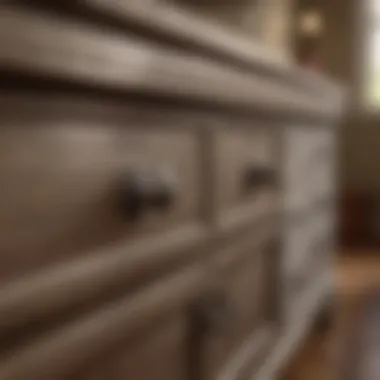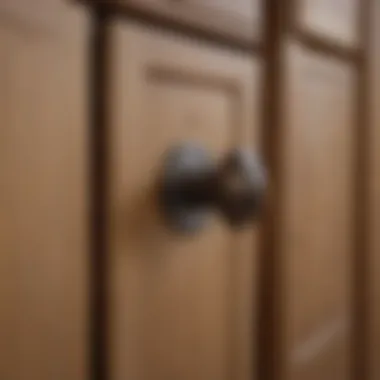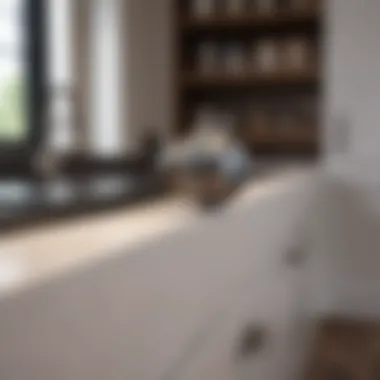Expert Guide to Installing Kitchen Cabinet Knobs


Intro
Installing kitchen cabinet knobs is a seemingly simple task that can drastically enhance your kitchen's aesthetic appeal. With the right techniques and tools, you can transform your space without the need for a full remodel. This guide will explore essential steps from preparatory work to ensuring the finish is exactly what you envisioned. Each phase of the installation process is intended to empower you, whether you are a novice or an experienced DIYer, to create a polished look in your kitchen.
To understand the significance of this task, consider the impact of hardware on the overall design of your kitchen. Well-chosen knobs can complement cabinetry and elevate your decor. They can be an expression of personal style, merging function and aesthetic seamlessly. As we dive deeper, we will discuss design inspiration and practical techniques, focusing on practical advice to achieve professional-looking results.
Prelude to Kitchen Cabinet Hardware
Kitchen cabinet hardware plays a crucial role in not just functionality but also aesthetics of the kitchen space. Cabinet knobs, in particular, are small yet impactful components that can transform the appearance of your cabinetry. They bridge the gap between style and practicality, allowing easy access to storage. An effective installation of these knobs can elevate the overall look of your kitchen. Moreover, it can complement the design theme you have chosen, whether it's modern, rustic, or transitional.
Choosing the right cabinet knobs involves considering their material, finish, and style, which together create a cohesive design element. This article will guide you through the installation process, ensuring you achieve results that are both attractive and durable. Understanding the characteristics of cabinet knobs can aid in making informed decisions, ultimately enhancing your home environment.
Understanding Cabinet Knobs
Cabinet knobs are not merely functional items; they are significant design elements that can unify decor or highlight individual cabinets. Generally made from diverse materials such as metal, ceramic, or glass, the choice of a knob should reflect your personal style as well as the kitchen’s aesthetic.
Knobs come in various shapes and sizes, which may influence both their practical use and visual impact. A larger knob might provide better grip, while a smaller one can create a sleek look. Furthermore, knobs can vary in terms of their installation method, some requiring screws, and others might use a simple adhesive. Grasping these differences is important while making decisions and during the installation process.
Types of Kitchen Cabinet Knobs
There are numerous types of kitchen cabinet knobs that cater to different tastes and practical requirements. Some of the most common types include:
- Classic Knobs: Often circular or rounded, these are timeless designs that suit almost every kitchen style.
- Contemporary Knobs: These knobs tend to have minimalist designs, often using materials like brushed nickel or matte black finishes.
- Vintage Knobs: Characterized by intricate designs and a more ornate shape, these knobs add a touch of history to any kitchen.
- Rustic Knobs: Typically made from wood or wrought iron, they evoke a natural, homey feel.
In addition to the style, one should also consider the finish of the knobs, as it can greatly affect how they interact with the surrounding elements. Choosing a finish that matches or complements other hardware in the kitchen, such as faucets or light fixtures, is key to achieving a cohesive look.
Essential Tools for Installation
Choosing the right tools makes a significant difference in the ease and quality of your cabinet knob installation. The process, while straightforward, can lead to frustrating results without the appropriate equipment. Having the proper tools on hand ensures accuracy, efficiency, and a professional finish, which is especially important when transforming your kitchen aesthetics.
Basic Tool Requirements
To begin with, you will need a few basic tools. These primarily include:
- Screwdriver: A standard Phillips screwdriver is essential for attaching the knobs. Having a magnetic tip can be particularly useful for holding screws in place.
- Drill: A cordless drill enhances speed and reduces physical effort compared to manual methods. It's ideal for creating holes and attaching screws, especially when working with harder materials.
- Measuring Tape: Precision in measuring distances between knobs and from the edges of the cabinets is key. A measuring tape ensures uniformity, which leads to a polished look.
- Level: To achieve a straight installation, especially across multiple knobs, a level is important. It helps in avoiding misalignment, which can detract from the visual appeal.
- Pencil: You will need a pencil for marking drill points. This simple tool is crucial for visualizing the placement before any permanent changes are made.
These essential tools form the foundation of your installation toolkit. Using them effectively will streamline your process and assist in achieving the desired end result.
Optional Tools for Precision
In addition to the basic tools, several optional tools can enhance your installation by providing greater precision:
- Hand Drill: While a power drill is common, having a hand drill allows for greater control when drilling pilot holes. It is particularly useful for delicate cabinet materials.
- Drill Bit Set: Different sizes of drill bits give flexibility for custom knob sizes, ensuring holes are made to spec.
- Template or Jig: A properly designed installation template can help you achieve consistent placement across multiple doors. It guides drill placement, reducing the risk of errors.
- Clamps: If you are working with several doors or drawers, clamps can hold them steady while you drill. This minimizes movement and enhances accuracy.
- Safety Glasses: Depending on your workspace, wearing safety glasses is advisable. They protect your eyes from debris during drilling or adjusting the knobs.
Utilizing these optional tools can significantly improve the quality of your work, making the process of installing kitchen cabinet knobs much smoother. Embracing precision not only enhances the visual appeal of your cabinets but can also improve their functionality.


Properly equipped, any DIY project transforms from a chore into an enjoyable task that results in satisfaction at the end.
Preparing for Installation
Preparing for the installation of kitchen cabinet knobs is a pivotal step that sets the foundation for a successful project. This stage involves careful planning and evaluation to ensure that every detail is accounted for. By adequately preparing, you can avoid common pitfalls that lead to dissatisfaction and costly mistakes down the road. This segment will discuss the nuances of properly preparing for installation.
Assessing Your Cabinets
Assessing the existing cabinets is the first task in the preparation process. Take time to examine materials, structure, and condition. Different materials like wood, laminate, or metal may require distinct approaches and tools during installation. Ensure the cabinets are clean and free from debris, as this not only aids in achieving a professional look but also ensures that the knobs adhere well.
Additionally, check for any structural issues, such as loose doors or damaged surfaces. Identifying these problems beforehand will allow you to address them, which ultimately contributes to the longevity of your newly installed knobs.
Choosing the Right Knob Placement
Choosing the right placement for your cabinet knobs greatly impacts functionality and aesthetics. The objective is to ensure that the knobs are placed in a position that is easy to reach and comfortable to use.
Typically, knobs should be positioned vertically on drawer fronts, around 2.5 to 3 inches from the top edge or bottom edge. For cabinet doors, a similar approach can be taken focusing on the center vertical axis. Consider the height and reach of individuals who use the kitchen most often to determine the most convenient placement.
Visualize the layout before making any permanent marks. Sometimes, marking the placement with painter’s tape can help visualize how the arrangement works. This step ensures you do not rush into positioning, which might lead to future dissatisfaction with the decor and usability.
Marking Installation Points
Once you have your knob placements identified, it’s time to mark the installation points. This step is critical because accurate marking helps prevent misalignment when drilling holes.
Use a measuring tape to get precise measurements and mark the spots with a pencil or a fine-tip marker.
- Double-check Measurements: Mistakes can lead to misaligned knobs which spoil the entire look.
- Utilize a Level: Using a level will ensure that knobs are uniformly aligned across the cabinets.
- Create a Template: For multiple drawers or doors, creating a template can lead to consistency and save time.
Properly marking points may seem tedious, but it is invaluable. It can save time and energy by preventing errors that would require rectification later.
By taking the time to prepare adequately, the installation will proceed more smoothly. This preparation ultimately results in a well-organized, functional kitchen with an enhanced aesthetic appeal.
Step-by-Step Installation Process
The step-by-step installation process is pivotal in successful kitchen cabinet knob installation. It provides a systematic approach. Following these steps ensures accuracy, reduces frustration, and leads to a polished final look. No matter the skill level, understanding this process can boost confidence and provide ownership over a home improvement task. This section breaks down each crucial step, highlighting how a methodical approach enhances both efficiency and results.
Drilling Holes for Knobs
Drilling holes for knobs is the first physical action in the installation process. Selecting an appropriate drill bit is essential. For most standard cabinet knobs, a 3/16-inch drill bit is often suitable, but always refer to the specific knob’s requirements. Locate the marked point on the cabinet door where the knobs will be fitted. Hold the drill perpendicular to the surface.
Before drilling, ensure the cabinet is steady to prevent movement. Start the drill slowly to create a clean hole without damaging the wood. Once the bit penetrates, increase speed gradually.
Consider using a clamp or backing board. This prevents chipping during the drilling process and can protect the finish of the cabinet. After drilling, clean up any debris to prepare for knob attachment.
Attaching the Knobs
Attaching the knobs follows the drilling step. Start by inserting the screw that comes with the knob through the hole drilled earlier. Make sure the knob is positioned correctly. The screw should go through the back of the cabinet door, connecting to the knob in front.


Tightening the knob securely is vital. Use a screwdriver, but take care not to over-tighten. This might crack the wood or damage the knob. An appropriate level of tightness ensures durability while maintaining proper aesthetics.
If knobs come with a backplate, ensure this is also aligned and attached appropriately. This adds to the design while providing additional security. Remember, the goal is not just to install but to enhance the cabinet’s overall look.
Ensuring Proper Alignment
Aligned knobs contribute significantly to a well-finished kitchen. After knobs are attached, stand back to visually assess if the alignment appears correct. Use a level if necessary, especially for larger cabinets or where multiple knobs are installed. Misalignment can detract from the overall appearance and functionality of the kitchen.
If adjustments are required, loosen the knob slightly, making necessary shifts. Once satisfied, retighten gently. Keep a consistent spacing between knobs, particularly when installing multiple knobs on larger cabinets.
As a final touch, clean the area around the knobs to remove any residue from installation. This will provide a neat appearance and complete the process effectively.
Troubleshooting Common Issues
When installing kitchen cabinet knobs, achieving a seamless and professional appearance is paramount. However, not all installations proceed without complications. This section addresses two prevalent issues: misaligned holes and wobbly knobs. By understanding these problems, readers will be able to take swift and effective action to rectify them, ensuring their knobs function correctly and enhance the overall aesthetics of the kitchen.
Dealing with Misaligned Holes
Misalignments can occur during the drilling phase of the installation process. This issue often arises from incorrect measurements or movement of the drill. The result can be unsightly gaps or, worse, knobs that pull away from the cabinet surfaces. Fixing misaligned holes is important, as it not only impacts the functionality of the knob but also affects the overall look and feel of the cabinetry.
To address misaligned holes, consider these steps:
- Assess the Situation: Determine how far off the holes are. If they are slightly misaligned, you may be able to adjust without needing extensive repairs.
- Filling Holes: If the holes are too far apart, you might need to fill in the misaligned holes. Use wood filler, then sand smooth once it's dried. Subsequently, you can re-drill new holes in the appropriate locations.
- Using a Template: For future installations, creating a drill template can help ensure accuracy. You can use a piece of cardboard to mark where the holes should go. This method minimizes the chance of future misalignments.
"Accurate placement is crucial for both function and aesthetics. Always double check your measurements before drilling."
Incorporating these strategies can save time and prevent frustration during the installation process. The focus should remain on accuracy to enhance the final outcome.
Fixing Wobbly Knobs
A wobbly knob can detract from the functionality and appearance of your kitchen cabinets. It may happen due to insufficient tightening of the screws, or wear and tear over time. Additionally, the problem might stem from poorly aligned accessories. Whatever the cause, the solution requires immediate action to restore the integrity and aesthetic of your cabinetry.
To fix wobbly knobs, follow these approaches:
- Tightening Screws: Often, a simple fix is to tighten the screws that hold the knob in place. Use a screwdriver to apply the appropriate amount of force. Be cautious not to overtighten, as this may lead to further issues down the line.
- Replacing Washers: If the knob is still wobbly after tightening, check if the washers (if applicable) are worn out. Replacing these can add stability to the knob.
- Correcting Installation: As in the case of misaligned holes, if the knob was installed with incorrect spacing, consider removing it and re-installing to ensure a snug fit against the cabinet surface.
Maintaining knobs should be a regular part of kitchen upkeep. Proper installation and ongoing checks will help prevent these issues. Recognizing potential problems early can lead to a more seamless and enjoyable cooking experience.
Finishing Touches
Finishing touches are critical in any installation process, including the installation of kitchen cabinet knobs. This phase is not merely about aesthetics but rather encompasses ensuring functionality, securing the installation, and preparing the space for everyday use. The importance of these final steps cannot be overstated, as they influence both the longevity of the knobs and the overall visual appeal of your kitchen cabinets.
Making sure that the knobs are firmly installed is of utmost importance. A loose knob can lead to major frustrations. Therefore, one should dedicate adequate time to this stage and pay attention to fine details.
Cleaning Up After Installation


Once the knobs are attached, it’s essential to clean the area. Removal of any dust or debris, leftover from drilling or installation, enhances the overall presentation of your hard work. Use a soft cloth and mild cleaning solution to wipe the cabinets and the knobs gently. Take care of the knob surface as well; some materials may be sensitive to harsh cleaners.
Furthermore, organize your tools and materials. A clean workspace contributes not only to safety but also to a more organized environment for future projects. Leaving behind tools or packaging can lead to clutter and potential accidents.
Final Inspection of the Knobs
The last step before declaring the project as complete is to conduct a thorough inspection of the knobs. Check for any wobbling or misalignment by gently tugging on each knob. If any issues arise, address them immediately before they become worse over time.
Additionally, confirm that all screws are tightened securely. Even minor looseness can lead to bigger problems later on.
Observe how the knobs operate and ensure they smoothly open the cabinet doors and drawers. This simple check can save you future headaches.
Ultimately, a few extra moments invested in inspection can dramatically effect the durability and performance of your cabinet knobs.
Maintenance Tips for Kitchen Cabinet Knobs
Maintaining kitchen cabinet knobs is vital for both functionality and aesthetics. Regular upkeep of these small details can significantly enhance the overall look of your kitchen. Cabinet knobs often endure frequent use, so they may accumulate dirt, grease, or even suffer from wear and tear over time. Knowing how to care for them can prolong their lifespan and keep your cabinets looking fresh. This section emphasizes practical maintenance strategies that are straightforward yet effective, ensuring that your knobs remain a beautiful part of your kitchen.
Routine Cleaning
Cleaning cabinet knobs regularly is a straightforward yet essential aspect of maintenance. Dust and grime build-up not only makes them look unattractive but can also cause functional issues over time. To clean your cabinet knobs:
- Use a soft cloth or a microfiber towel to gently wipe down the surface.
- For stubborn stains, a mixture of warm water and mild dish soap is effective. Dip the cloth into the solution and wring it out before applying it to the knobs.
- Rinse with a clean, damp cloth to remove soap residue, and dry thoroughly to prevent water spots.
This routine should be part of your regular kitchen cleaning schedule. Performing this simple task monthly helps keep knobs looking new, enhancing the appeal of your kitchen as a whole. Additionally, if you have chosen decorative knobs, keeping them clean ensures that intricate designs remain visible.
Identifying Wear and Tear
Recognizing signs of wear and tear is crucial for timely intervention. Knobs can become loose, tarnished, or stained if not regularly checked. Here’s what to look for:
- Looseness: If you notice that knobs feel wobbly, it may indicate that the screw has loosened. This can lead to further damage if not addressed.
- Tarnished or scratched surfaces: For metal knobs, discoloration or scratches may occur over time due to different factors, including cleaning agents or friction.
- Stiff movement: If a knob does not turn smoothly, there may be dirt trapped inside or damage to the hardware.
Regularly inspect your cabinet knobs. Addressing these issues early on can prevent more significant problems down the line, which may require replacement. By keeping all these factors in check, you maintain not just the appearance but also the functionality of your kitchen cabinet knobs.
Closure
In this article, we have discussed the essential steps involved in properly installing kitchen cabinet knobs. The conclusion serves as a vital section, emphasizing key elements of the installation process, its benefits, and critical considerations for achieving a professional look.
Summary of Steps Involved
To successfully install kitchen cabinet knobs, you must first gather the necessary tools and prepare your workspace. The basic steps include assessing your cabinets, marking the correct positions for your knobs, and then drilling holes with precision. Next, the actual attachment of the knobs requires attention to detail. Finally, conducting a thorough inspection is paramount to ensure everything is aligned and secure.
By summarizing these steps, readers grasp that a methodical approach is fundamental to the installation process. This organization not only prevents mistakes but also enhances the overall aesthetics of the kitchen.
Importance of Proper Installation
Proper installation of kitchen cabinet knobs contributes significantly to both functionality and design. Knobs that are installed correctly facilitate ease of use. They offer smoother operation when opening and closing doors. Additionally, the right placement can greatly enhance the visual appeal of your cabinetry.
Furthermore, the durability of the hardware is also affected by how well it is installed. Knobs that are not securely attached could lead to potential damage over time, which may necessitate costly repairs or replacements.
Above all, a well-executed installation reflects care and attention to detail in home improvement. The procedure might appear straightforward, but acknowledging its significance can influence the overall success of your kitchen remodeling efforts.
Effective installation is not just about fitting hardware; it is a vital part of your home's decor ethos.



